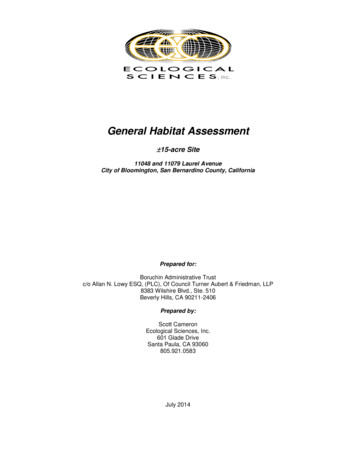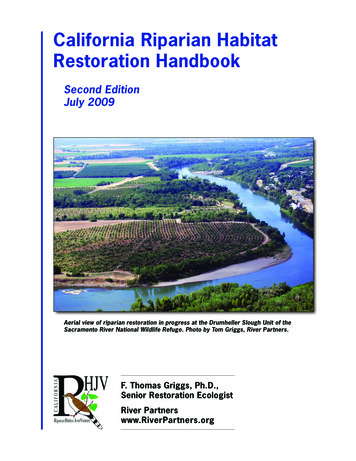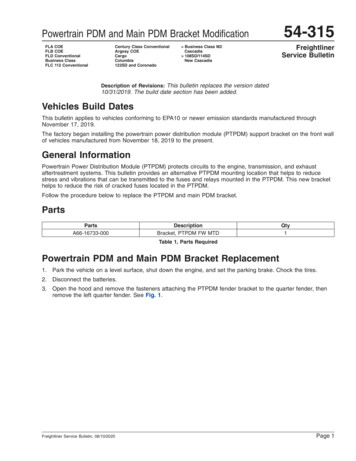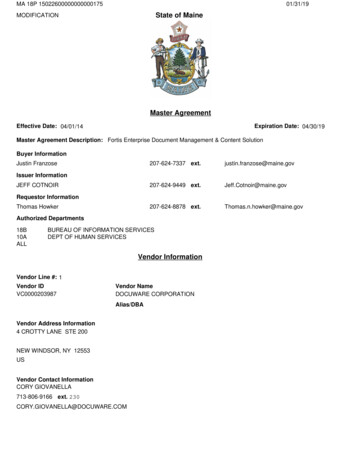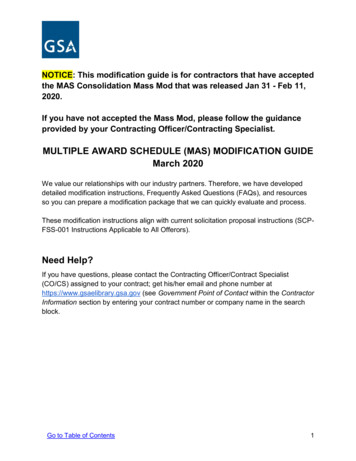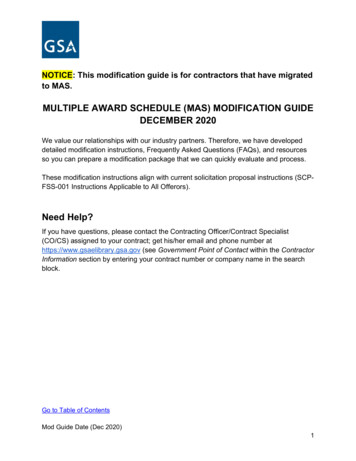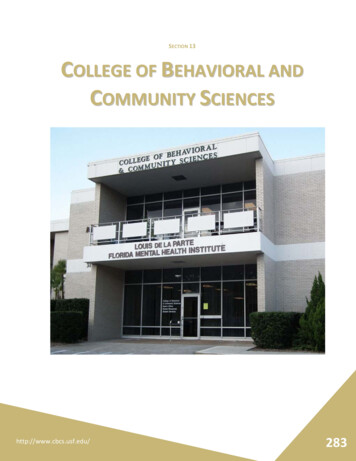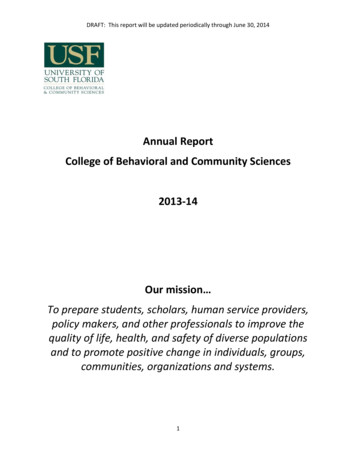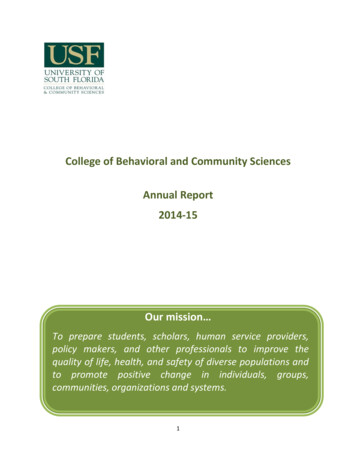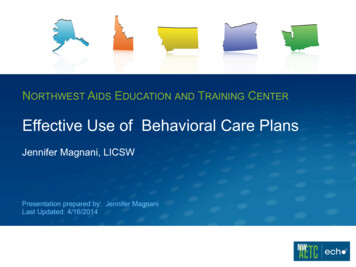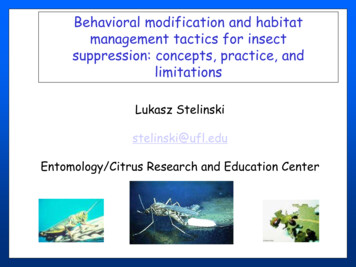
Transcription
Behavioral modification and habitatmanagement tactics for insectsuppression: concepts, practice, andlimitationsLukasz Stelinskistelinski@ufl.eduEntomology/Citrus Research and Education Center
Outline:›The Push-Pull Strategy for Pest Management-From the research and teaching ofmy PhD advisor-J.R. Miller (MSU)›Habitat management for pest control-From the research and teaching ofD. Landis, Professor (MSU)›Use of pheromones for pest control-From my research and collaboration withS. Lapointe (USDA-ARS)
Push-Pull:›››››››What is the concept and who came up with it?How is it used in pest management?What were some of the origins of it’s use?How do you set it up to work in the field?What are its strengths?What are its limitations?Can it be applied in citrus for ACP control?
The Push-Pull Tactic was developed consideringthe “basic principles of insect populationsuppression
E. F. Knipling 1979USDA Gov’t Publication
Parameters of Damage to Crops:DamageDxA xS xT
Parameters of Damage to Crops:DamageDxA xS xT
Major tactics for managing chemicaldefensetillageinsecticidesnaturalenemies repeldeterattracttrap
InsecticidesDamageDxA xS xT
Resistant VarietiesDamageDxA xS xT
Behavioral Manipulations:deterrents, repellents, attractants, anti-feedantsDamageDxA xS xT
Behavioral Manipulations:deterrents, repellents, attractants, anti-feedantsDamageDxA xS xTEffects can vary over time due toshifting behavioral thresholds
Rolling - Fulcrum Model-Developed by J.R. MillerOlfactionTasteTouchVisionE excitatoryI InhibitoryEEI.IEIAcceptEII. .Rolling FulcrumIIINotAccept
What is the concept of PUSH-PULL ?
What is the concept of PUSH-PULL ?It is the simple idea of combining two forcesto move something away from where you don’twant it and toward where you do want it.
What is the concept of PUSH-PULL ?It is the simple idea of combining two forcesto move something away from where you don’twant it and toward where you do want it.The idea is that by combining the force of pushwith the force of pull, the job gets done betterthan with either force alone. In some cases theeffect can be synergistic.
What is the concept of PUSH-PULL ?It is the idea of combining two forcesto move something away from where you don’twant it and toward where you do want it.The idea is that by combining the force ofpush with the force of pull, the effect on thepest is better than it would be if you usedeither force alone
Origins of Push–Pull in pest management—
J.R. Miller’s research onbehavioral manipulationsof onion fly
Deterrents alone wereunsuccessful
% Maximum Response100Onion fly806040200Ovipositional Resource Quality
The main chemical emitted by onion is:dipropyl disulfide CH3CH2CH2-S-S-CH2CH2CH3
% Maximum Response10080oOnion flyo Harris ExperimentWeston Experiment6040o200 o0oo12oo34Number of Optimized Factors5
Cull onions – large onionbulbs; sprouting andnot marketable
Cull Onions(Trap Crop)Seedling Onions(Valued Crop)Seedling Onions(Valued Crop)
Cull Onions(Trap Crop)FlySeedling Onions(Valued Crop)DeterrentsPUSHFlyAttractantsPULLSeedling Onions(Valued Crop)
Dr. Martin Rice working with Heliothis moth pests of cotton inAustralia independently came up with the push - pull ideasimultaneously. Martin and colleagues published a trade article onthis approach in the Australian Cotton Grower and a shortsummary in a Heliothis workshop proceedings. He called it thepush-pull approach and that name for the tactic became accepted.Plantings of pigeon-pea served as the PULLNeem (azadirachtin) served as the PUSH
Dr. John Pickett. Rothamsted Experimental Station.Institute of Arable Crops Research,Rothamsted, Harpenden. AL5 2JQ Hertfordshire.England.Pickett became the champion of the Push-Pull approach
A classic push-pull example
A classic push-pull exampleMaize Stemborercan destroy up to 80% ofthe maize cropStriga -- witch weedparasitic plant that canreduce yields by 20–60%
NapierGrassMaizeSilverleaf(Desmodium)Stemborers reduced by 30-80%Witchweed reduced by 50%SudanGrass
Some other examples:Pickett and coworkers –several aphid speciesuse plant volatiles as repellentsuse other volatiles and pheromones as attractantspea and bean weevils (Smart et al., 1994)use aggregations pheromone enhanced with plantvolatiles as pulluse volatiles from repellent plants as the push
Some other examples:Bark beetlesJohn Borden and co-workers commencingearly 1990s; use aggregation pheromones forthe pull and several well-known antiaggregation chemicals for the push.Shea and Neustein (1995) saved a stand of rareand highly valuable pines using a variationof the Borden approach
Example from urban pest:German cockroachNalyanya et al. (2000)RRRRRRRARtoxic baitA
Example from urban pest:German cockroachNalyanya et al. (2000)RRRRRRRARtoxic baitPush-Pull “Corralling”A
Advantages of Push – Pull : Environmentally friendly Is compatible with biological control Can have side benefits Can spawn new productse.g., Desmodium seed production Likely to be sustainable because theforces of selection are not overwhelming
Down-sides of Push – Pull : Tends to require considerable work and attention Potency of control may not rival insecticides Like other behavioral controls, this tactic tends tobe quite sensitive to pest density.Typical insecticides operate quite independently ofpest density.
Repellent plants at houseeves: Corymbia, Ocimum (Push)Cattle available foralternative blood source (Pull)
Ovi-traps deployed in/around the house (Pull)Repellent plants deployed around productive larval habitats (Push)
Applications for Citrus In India, Garlic plants (which deter manypests) are inter-cropped with citrus
In Asia, citrus is often interplantedwith guava
Effect of Citrus/GuavaInterplanting on ACP densityInterplanted and monoculture plots 1 km apartLower adult densitiesLower nymph densitiesHall et al. 2008
Disease Incidence (%HLB)In Guava-Citrus interplanted orchards, no incidence of HLBIn Citrus monoculture, HLB increases after 5 monthsMost monocultures die within 2-3 yearsGuava interplants reported to last 15 or more years without HLBHall et al. 2008
GuavaCitrusMethan.DMSH2SSO2Response - MilliVolts600DMDSGuava releases large amounts of sulfurcompounds in response to damage400Damaged200Non-Damaged02.03.04.0Time - Minutes-Dimethyl Disulfide (DMDS) is a known insect repellent-DMDS is also a known insect neurotoxin5.06.0Rouseff et al.2008
Percent psyllid responseSulfur compounds repel psyllids in the lab100a80100 pg/ ml of truswithDMTSCitruswithDMDS DMTS
Treatment of citrus with DMDS5 replicated 0.4 acre plots of sweet orangecv. ‘Valencia’Treatments:1) DMDS-treated plots2) Untreated control
Mean SE number of ACPper 10 trees per replicateApplication of DMDS can reducepsyllid populations in the field54*3***2*200 disperserper acre10Pre3Treatment*ControlDMDS3 kg DMDSper acre7111421Days after treatmentSignificantly different by Student t-test28
Potential application of Push-Pull forCitrus Pest Management:For Push-Use repellent. Can either use a plant (alliumsp. or Guava). Or can possibly use synthetic repellentlike sulfur compounds that repel psyllidsFor Pull-Use attractant plant. Perhaps sacrifice a rowof citrus that is heavily pruned and fertilized to keepproducing new flush that will act as psyllid attractant.Or, alternatively, plant Murraya hedge rows aroundcitrus grove to act as attractant.One in a while, spray trap-crop attractant withinsecticide to kill off psyllids.
Conclusions:Push-Pull is very common-sense ideaIt is still young as a formalized tactic:its full scope remains to be worked out;e.g., nature of possible synergisms betweenpush and pull (additive; multiplicative, other)It is probably most likely to be adopted and sustainedin situations where insecticidal controls are notavailable.It is no silver bullet; it probably will operate bestin an setting where this tactic is integrated withvarious other tactics (Killeen et al., 2004).It’s possible dependency on pest density needsto be understood and respected.
Habitat managementmodify habitat to modify insectbehavior for pest control– Disturbance and agriculturallandscape structure– How landscape structure affectsnatural enemies– Habitat management to improvebiological control– Thoughts on designing agriculturallandscapes
Disturbance “Any relatively discrete event in timethat disrupts ecosystem, communityor population structure and changesresources, substrate availability orthe physical environment.”Pickett and White 1985
Crop Landscapes DisturbanceRegime– Frequent– Intense– Uniform Result– Uncouples naturalenemies and nonhost resources
What Beneficial Insects Need Food– Pollen– Nectar Shelter– Overwintering sites– Moderate microclimates– Refuge from tillage,pesticides etc. Hosts/Prey– Primary– Alternate
Conservation BiologicalControlManipulation of the environment to enhancethe survival, fecundity, longevity, andbehavior of natural enemies to increasetheir effectiveness.Habitat ManagementA subset of conservation biological controlmethods that alters habitats to improveavailability of the resources required bynatural enemies for optimal performance.Landis, Wratten and Gurr 2000 Annu. Rev. Entmol.
Habitat Management“Beetle Banks”“Sown Weed Strips”
Carabids as GeneralistPredators
Manipulating Arthropod y11.5 m0.15 mplot
% Pupae Removed(arcsin trans.)Pupal Consumption235302520151050R 0.70260246Number of Beetles (sqrt transformed)Four most predominant beetle species: P. melanarius, P.chalcites, P. lucublandus, P. permundusMenalled et al. 1999. BioControl. 43: 441-456
Carabid Refuge StripExperiment
Carabid Species Richness4035302520Species Richness1510501996199719981999Carmona & Landis 1999. Environ. Entomol. 28: 1145-53.Lee et al. 2001. J. Appl. Ecol. 38: 472-483
Mean Number a & Landis 1999. Environ. Entomol. 28: 1145-53.Lee et al. 2001. J. Appl. Ecol. 38: 472-483
32 mExperimental Site66 mBlock IBlock IIBlock IIIBlock IVRefuge stripControl cornstrip15m x 15m plotwith plasticbarriersInsecticidetreated areas
Mean carabids capturedCarabid Activity-Density 20100Sampling daterefuge-untreated cropcontrol-untreated croprefuge-treated cropcontrol-treated crop
Habitat Management Know what pestsyou hope to reduce Know what types ofnatural enemies tofavor Design habitats tofavor specificbeneficials
Habitat Management forBeneficials Through theYear Winter Provide suitable overwintering sites– Sheltered locations– Plant residue– Cover crops
Habitat Management forBeneficials Through theYear Spring– Early spring green-up– Food– Shelter
Habitat Management forBeneficials Through theYearSummer– Diversity of flowering plants– Overlap of blooming periods– Accessible nectar
Habitat Management forBeneficials Through theYearSummer Cont.– Alternative hosts/prey– Moderated microclimates
Habitat Management forBeneficials Through theYear Fall– Limit residue burial– Plant cover crops
Some Additional Guidelines Consider wind and water flow patterns – Soil and water retentionConnectivityCloser is betterA little is better than none at allPerennial & annual habitatsAdditional sources of income– e.g. timber, nursery stock, cut flowers Aesthetic and wildlife considerations
Mating Disruption:››››››What is the concept?How does it fit into pest management broadly?What are the actually mechanisms underlying?How have we figured out how it works?What’s the future?What are its limitations?
Communication among mothsWindPheromone plume Females release pheromonefrom specialized glands Straight chain ca. 12-14 carbonalcohols, acetate, aldehydes Typically blends of 3-4 compounds Antennal sensilla siftpheromone moleculesfrom the air Odorant stimulatesreceptor cells withinantenna
What is the “normal” situation ?
What is the “normal” situation ?female
What is the “normal” situation ?gentle windfemale
What is the “normal” situation ?gentle windfemale
What is the “normal” situation ?gentle windfemale
What is the “normal” situation ?gentle windfemale
What is the “normal” situation ?gentle windfemale
What is the “normal” situation ?gentle windfemale
What is the “normal” situation ?gentle windfemale
What is the “normal” situation ?gentle windfemale
What is the “normal” situation ?gentle windfemale
What is the “normal” situation ?gentle windfemale
What is the “normal” situation ?gentle windfemale
What is the “normal” situation ?gentle windfemale
What is the “normal” situation ?gentle windfemale
What is the “normal” situation ?gentle windfemale
What is the “normal” situation ?gentle windfemale
What is the “normal” situation ?gentle windfemale
What is the “normal” situation ?gentle windfemale
What is the “normal” situation ?gentle windfemale
What is the “normal” situation ?gentle windeggs
What is the “normal” situation ?gentle windeggsMating disruption is intendedto stop this !!
HOW DOES IT WORK?gentle windeggsMating disruption is intendedto stop this !!
Alternative models (explanations) for mating disruption:1. Desensitization – males cannot find calling femalesbecause pre-exposure to pheromone causes loss ofsensitivity in antennae or brain.
Alternative models (explanations) for mating disruption:1. Desensitization – males cannot find calling femalesbecause pre-exposure to pheromone causes loss ofsensitivity in antennae or brain.
Alternative models (explanations) for mating disruption:1. Desensitization – males cannot find calling femalesbecause pre-exposure to pheromone causes loss ofsensitivity in antennae or brain.
Alternative models (explanations) for mating disruption:1. Desensitization – males cannot find calling femalesbecause pre-exposure to pheromone causes loss ofsensitivity in antennae or brain.
Alternative models (explanations) for mating disruption:1. Desensitization – males cannot find calling femalesbecause pre-exposure to pheromone causes loss ofsensitivity in antennae or brain.
Alternative models (explanations) for mating disruption:1. Desensitization – males cannot find calling femalesbecause pre-exposure to pheromone causes loss ofsensitivity in antennae or brain.
Alternative models (explanations) for mating disruption:1. Desensitization – males cannot find calling femalesbecause pre-exposure to pheromone causes loss ofsensitivity in antennae or brain.
Alternative models (explanations) for mating disruption:1. Desensitization – males cannot find calling femalesbecause pre-exposure to pheromone causes loss ofsensitivity in antennae or brain.
Alternative models (explanations) for mating disruption:2. Camouflage – males cannot find calling females becauseof interference from an atmospheric background ofpheromone released from dispensers.
Alternative models (explanations) for mating disruption:2. Camouflage – males cannot find calling females becauseof interference from an atmospheric background ofpheromone released from dispensers.
Alternative models (explanations) for mating disruption:2. Camouflage – males cannot find calling females becauseof interference from an atmospheric background ofpheromone released from dispensers.
Alternative models (explanations) for mating disruption:2. Camouflage – males cannot find calling females becauseof interference from an atmospheric background ofpheromone released from dispensers.
Alternative models (explanations) for mating disruption:3. False-plume-following (Competition) – males arediverted from orienting to authentic females due tocompeting attraction to nearby false plumes frompheromone dispensers.
Alternative models (explanations) for mating disruption:3. False-plume-following (Competition) – males arediverted from orienting to authentic females due tocompeting attraction to nearby false plumes frompheromone dispensers.
Alternative models (explanations) for mating disruption:3. False-plume-following (Competition) – males arediverted from orienting to authentic females due tocompeting attraction to nearby false plumes frompheromone dispensers.
Alternative models (explanations) for mating disruption:3. False-plume-following (Competition) – males arediverted from orienting to authentic females due tocompeting attraction to nearby false plumes frompheromone dispensers.
Alternative models (explanations) for mating disruption:3. False-plume-following (Competition) – males arediverted from orienting to authentic females due tocompeting attraction to nearby false plumes frompheromone dispensers.
Alternative models (explanations) for mating disruption:3. False-plume-following (Competition) – males arediverted from orienting to authentic females due tocompeting attraction to nearby false plumes frompheromone dispensers.
Alternative models (explanations) for mating disruption:3. False-plume-following (Competition) – males arediverted from orienting to authentic females due tocompeting attraction to nearby false plumes frompheromone dispensers.
Alternative models (explanations) for mating disruption:3. False-plume-following (Competition) – males arediverted from orienting to authentic females due tocompeting attraction to nearby false plumes frompheromone dispensers.
Alternative models (explanations) for mating disruption:3. False-plume-following (Competition) – males arediverted from orienting to authentic females due tocompeting attraction to nearby false plumes frompheromone dispensers.
Alternative models (explanations) for mating disruption:3. False-plume-following (Competition) – males arediverted from orienting to authentic females due tocompeting attraction to nearby false plumes frompheromone dispensers.
Alternative models (explanations) for mating disruption:3. False-plume-following (Competition) – males arediverted from orienting to authentic females due tocompeting attraction to nearby false plumes frompheromone dispensers.
Alternative models (explanations) for mating disruption:3. False-plume-following (Competition) – males arediverted from orienting to authentic females due tocompeting attraction to nearby false plumes frompheromone dispensers.
Alternative models (explanations) for mating disruption:3. False-plume-following (Competition) – males arediverted from orienting to authentic females due tocompeting attraction to nearby false plumes frompheromone dispensers.
Alternative models (explanations) for mating disruption:3. False-plume-following (Competition) – males arediverted from orienting to authentic females due tocompeting attraction to nearby false plumes frompheromone dispensers.
Alternative models (explanations) for mating disruption:3. False-plume-following (Competition) – males arediverted from orienting to authentic females due tocompeting attraction to nearby false plumes frompheromone dispensers.?, #@ % !
Commercial disruption formulations:Rate: 1-2 / acre1) Hand-applied dispensers (ropes)Rate: 200-500 / acre2) Aerosol emitters 300,000 X’s a calling female / unit600-1000 X’s a calling female / unit3) Sprayable microencapsulated formulationsGreatlymagnified
Development of high-density wax-drop formulation Paraffin- or microcrystalline-waxformulation Contains 5-10 % pheromoneby weight Formulations are made of 30-40%wax and 50-60% water Anti-oxidants and proprietarystabilizers protect pheromone
Progress toward high-perfor
›The Push-Pull Strategy for Pest Management-From the research and teaching of my PhD advisor-J.R. Miller (MSU) ›Habitat management for pest control-From the research and teaching of D. Landis, Professor (MSU) ›Use of pheromones for pest control-From
